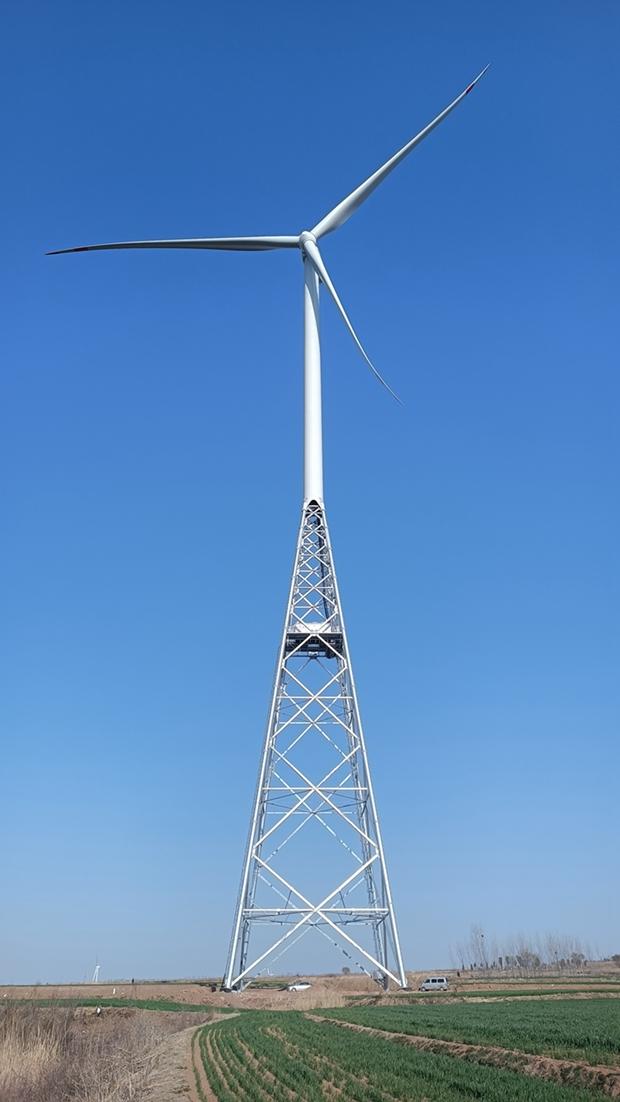
 0 Comment(s)
0 Comment(s) Print
Print E-mail China.org.cn, December 1, 2024
E-mail China.org.cn, December 1, 2024
Chinese wind energy manufacturer Huastro is confident in its high-altitude turbine tower technology and seeks global partners, the company told China.org.cn Saturday at the second China International Supply Chain Expo (CISCE) in Beijing.

The current world's tallest prestressed frame anti-fatigue steel tube wind turbine tower, measuring 170 meters in height, is located in Jiaozhou, Shandong province. A 185-meter-high tower is under construction in Boli county, Heilongjiang province, and will surpass the record held by the Jiaozhou project. [Photo courtesy of Huastro]
Before exhibiting at the expo, Huastro achieved significant progress on one of its projects. On Nov. 14, in collaboration with Goldwind, the firm achieved a key milestone by successfully installing a crucial transition section for a project in Boli county, Heilongjiang province, where temperatures can drop to minus 33 degrees Celsius. The installation demonstrates the adaptability of the company's wind turbine tower technology to extreme weather conditions.
The Boli project will feature the world's tallest prestressed frame anti-fatigue steel tube wind turbine tower, standing at a height of 185 meters.
Zhang Longgang, general manager of the Huastro Production Center, said that technological innovation drives the company's development. The firm's R&D team collaborated with Tongji University to develop the new high-altitude towers. The innovation has secured more than 30 invention patents, with approvals from patent offices in the United States, Europe and India.
The technology solved a key industry bottleneck in height limitations. Traditional wind towers couldn't safely exceed 140 meters, but the new technology enables secure construction beyond 200 meters, allowing better access to wind resources at higher altitudes.

A New Zealand delegation tours Huastro's booth during the second China International Supply Chain Expo in Beijing, Nov. 29, 2024. [Photo courtesy of Huastro]
Zhang noted that this technology is adaptable to diverse scenarios, stating: "It is suitable for construction over ponds, ditches and roads, allowing vehicle passage beneath the tower base. The technology adapts to unused rural land, uneven mountain terrain, high-shear areas and flood zones. It also performs effectively in extremely cold regions and areas with marshy, soft soil foundations."
Huastro's practices support China's green development goals by reducing steel and concrete usage, according to Zhang. The company's towers have a 20-year lifespan and can be reused, requiring only 6 square meters of space and allowing wind farm renovations without removing old foundations. This method not only cuts costs and construction time but also allows for agricultural activities beneath the structure and facilitates easy recycling after use, thereby optimizing and enhancing sustainable land use.
These practices also align with the company's environmental goals. "The technology effectively reduces noise emissions," Zhang said. The low-noise towers allow birds to coexist nearby.
The design also uses less steel and concrete in its foundations to reduce raw materials. Zhang mentioned that the frame structure requires no blasting for disposal and is easily dismantled for recycling, supporting China's green development initiatives.

China Resources Group delegation tours Huastro's booth during the second China International Supply Chain Expo in Beijing, Nov. 26, 2024. [Photo courtesy of Huastro]
Huastro attended this year's CISCE, which concluded on Nov. 30, seeking global partners and expecting that more companies would recognize its advantages. The company received positive responses, with firms from India and Germany initiating inquiries and negotiations. The company plans to return to the expo next year.
Founded in 2001 and based in Qingdao, Shandong province, Huastro began by building communication, power and broadcast television towers. In 2018, after strategic transformation and rebranding, the company focused on wind turbine tower technology development and installation, along with environmental protection technologies. It has built 21 wind turbine towers so far, with 40 under construction and 200 more ordered.